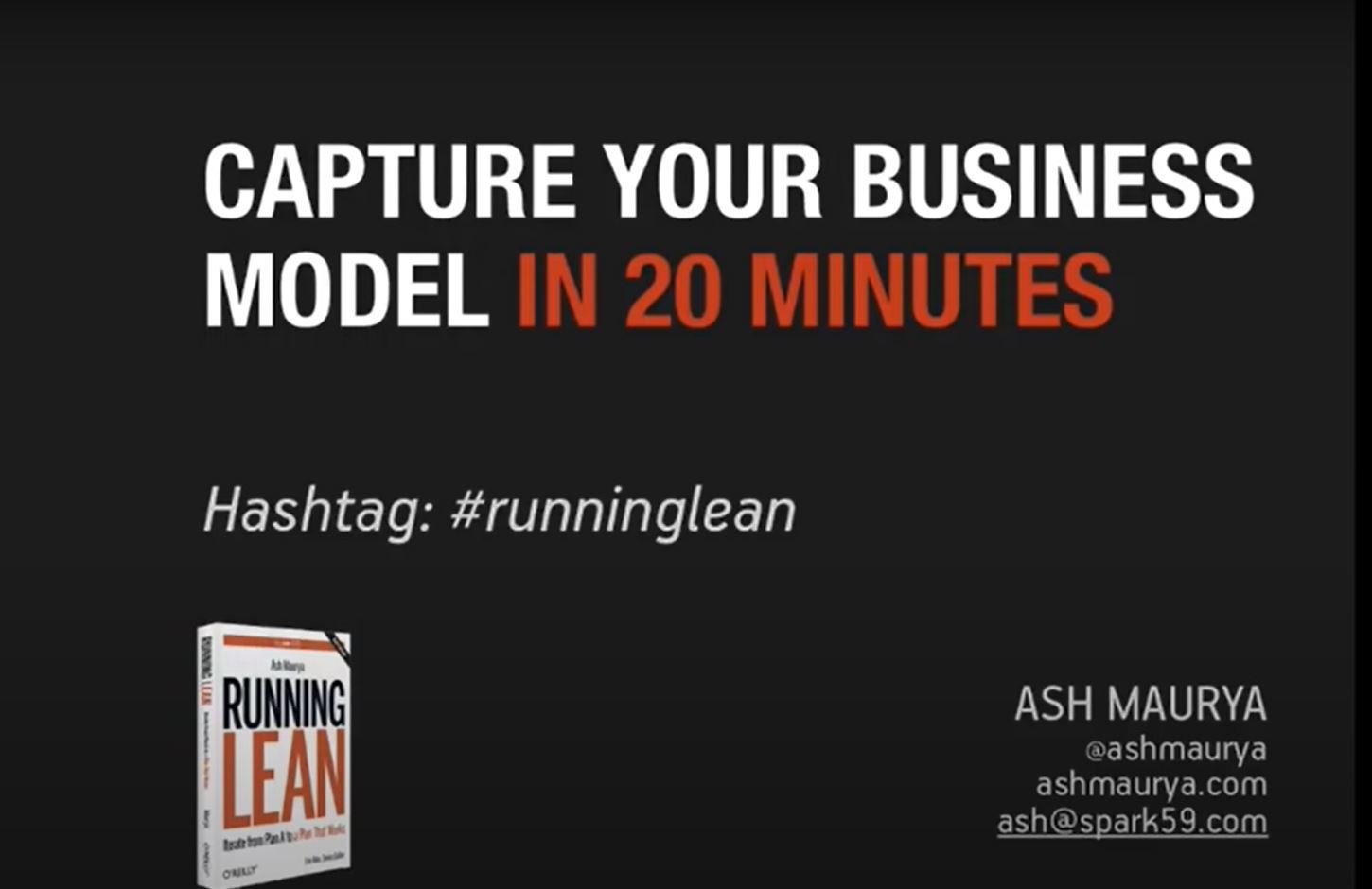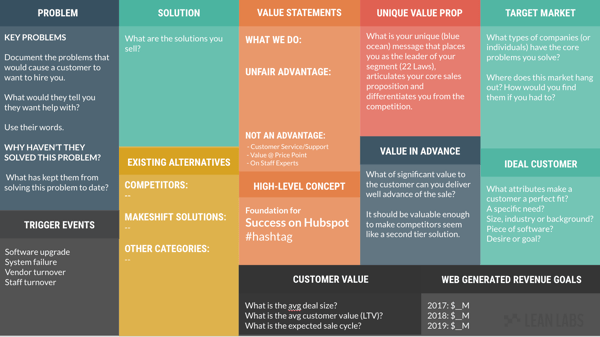His company, Hardbound, which was an app that features illustrated summaries of non-fiction books, was only generating $2,500 a month. Despite having over 100,000 downloads in the App Store, and nearly 20 million pages of content page views, their investors felt the company did not have enough user growth.
Like many other entrepreneurs in this situation, Bashaw needed to understand where he went wrong, so he dug in and did the critical work and research necessary to figure out why the user growth was off.
But if you have one critical tool, you can help avoid this type of failure altogether. Because for many founders, the answer lies within one strategy document, the lean startup canvas.
What's The Lean Startup Canvas, Anyway?
The Lean Startup Canvas, a methodology that Ash Maurya created, is based on The Business Model Canvas by Alex Osterwalder. The one-page strategy document enables founders and CEOs to leverage the innermost desires of their ideal customer.
Ash Maurya believes creating a 10, 20 or 100-page business plan is pointless. From that belief came The Lean Startup Canvas, a one-page strategy template that documents the business model from a customer-centric perspective. Here at Lean Labs, the template acts as a quick check into the health of an organization, and how much they know about their customer.
Rather than spending precious time and budget on developing messaging for the wrong customer, about the wrong problem, for the wrong demographic, The Lean Startup Canvas creates a framework to kick off your strategy. In Ash Maurya's opinion, creating this concise summary first is critical to success.
"If you are spending more than 20 minutes on your initial business model canvas, you are doing it wrong."-Ash Maurya, Author of Running Lean and Scaling Lean
You can see more about Maurya's approach in this video that covers each section of his template. It's one of many canvas templates out there, but our experience, it's the best.

We have a version of Maurya's template we use to conduct initial customer research and establish a customer-centric mindset.
It looks like this, and you can access it by downloading our SprocketRocket Strategy Kit.

The document has the following sections:
- Customer Problems
- Solutions
- Trigger Events
- Existing Alternatives
- Value Statements
- High-Level Concept
- Unique Value Proposition
- Value in Advance
- Target Market
- Ideal Customer
It seems like a lot of information, but each section only has room for a concise response. The limited space helps us focus on what matters the most, and create a business model that matches our ideal customer. Step-by-step, I'll show you how you can fill in the template successfully and master The Lean Startup Canvas.
#1. Do You Know Your Customer's Problem?
For businesses, tapping into customer problems is critical. The tech startup Unpakt is proof. After failing to address the frustrations of their customers, the company found themselves clueless about the actual struggles of their customers.
"We were so sure that the biggest problem in moving was the lack of accessibility and ease that it took us by surprise when moving companies and moving customers didn’t flock to the site." - Adam Doron, CEO at Unpakt
As a result, the team at Unpakt began to deploy user testing strategies. By offering rewards for feedback, conducting ongoing research and tracking individual use cases on the website, a picture began to emerge. Rather than feeling frustrations around the lack of ease in moving, the ideal Unpakt customer thought they could not trust moving companies.
With that information, the team could finally tap into their customer's pain points and help establish that trust. You can uncover the same types of insights during The Lean Startup Canvas approach. If you don't know your customer problems, you can use a few methods to find out, such as:
From there, you can use their actual feedback and behavior to reveal their problems.
#2. How Are Your Solutions Changing Lives?
Apple, everyone's favorite tech giant, masters customer solutions. The company has a constant focus on how their products add value to their customer's life, providing invaluable insights that guide their entire marketing strategy.
“The most important component to the Apple experience is that the staff isn't focused on selling stuff. It’s focused on building relationships and trying to make people’s lives better.” - Ron Johnson, Former Head of Retail at Apple
While the Apple Watch is a product, it also offers an array of solutions to various industries. Capital One equips their staff with Apple Watches to foster collaboration, and AETNA provides the watches as a part of their corporate wellness program. Your solution is how you and your product will make your customer's life better.
#3. What Forces Your Customer To Act?
Everyone runs out of storage, and it can be very frustrating. Your work computer will alert you that you're running out of space, or your phone slows down significantly because of all of your photos and videos. You panic and try to figure out how to solve the problem. We call this a trigger event, and it's where the file hosting service Dropbox thrives.
The company uses the catalyst to convert free users into paying customers.
"Dropbox has grown to well over 300 million by giving new users 2GB of free space and then offering paid plans that start at $9.99/month."- The Next Web
When you define customer trigger events, you can find tactics to convert your customer. For Dropbox, the trigger is running out of free storage, and the result is a sequence that encourages the customer to opt in for a paid monthly subscription.
To find out why your customer enters the buying cycle, you can use a buyer journey or customer journey mapping exercise. Both tools help you adopt a customer-centric perspective, and will help complete this part of the lean canvas template.
#4. What Are The Alternatives To Your Service?
You're not the only solution out there, as competitors and temporary fixes exist for your customer. In the next step of the canvas, you want to get ahead of those existing alternatives by identifying every other way your customer can solve their problem.
For Venmo (PayPal Holdings), an app that helps you reimburse friends, family, and co-workers for expenses, these ongoing alternatives include cash, checks, and IOUs. Using these existing alternatives, Venmo can position throughout their messaging how they are the better option.
"When you go out to dinner with a friend or share a cab or go on a weekend getaway and want to split the bill, Venmo is almost always the easiest option. People never have the right amount of exact cash, and who actually uses checks anymore? Venmo is the easiest option." - TechCrunch
Using the pain points your ideal customer has for the alternatives, you can show how you resolve them throughout conversion and lead generation pages.
#5. What's Your Company's Secret Weapon?
Your value statement will define what you do, and why it's an unfair advantage in your field. Stitch Fix, one of many subscription box services for apparel, found their differentiator in an unexpected place for fashion: data. By collecting and studying customer data, the team at Stitch Fix determines the intent behind searches and queries and make personal recommendations.
"We’re not up-selling you belts that match that blouse you just added to your cart, or touting a certain brand because you’ve bought it before or using browsing patterns to intuit that you might be shopping for a little black dress—all activities that have low conversion rates. Instead, we make unique and personal selections by combining data and machine learning with expert human judgment." - Katrina Lake, CEO at Stitch Fix
The focus on data helps Stitch Fix anticipate their customer needs, provide consistent value, and outperform their competitors. If you can identify what gives you the upper hand, you can use it to build trust with your customer and make the best use of your differences.
#6. Can You Explain Your Concept In Four Words?
Your high-level concept is your pitch and your sound bite. It's useful for every company, but especially for the ones within traditionally complex industries. Lemonade Insurance, known for their simplified approach to insurance, uses their quick pitch to help their customer connect the dots about what their service does, and does not do.
“We think if you’re optimizing for the consumer, giving them clarity into exactly what’s covered and exactly what isn’t, you won’t feel cheated if we can’t cover things because you’ll see that you had that info all along, in plain English." - Bricker & Eckler
Overall, services that are easy to "get" right away are more memorable. This part of the lean canvas is perfect for developing taglines, headlines, ad copy, and more.
#7. How Are You Different From Everyone Else?
Not to be confused with the high-level concept, your unique value proposition articulates your core sales proposition and differentiates you from the competition. HubSpot, who is already known for their sales and marketing expertise, kills it with their UVP.
"HubSpot is a classic example of great techniques. With everything that they offer they use the phrase to GROW YOUR BUSINESS. This provides a common goal with their visitors while easily encompassing all they offer their customers. It's simple, yet effective." - Ryan Scott, Head of Inbound Marketing at Lean Labs
A strong UVP will communicate your benefit in seconds and place you as the leader of your segment. You can use it to bolster your website and landing page copy.
#8. How Can You Promise Value in Advance?
The graphic-design tool website Canva uses their ease-of-use to contrast against complex competitors like Adobe Photoshop and Adobe InDesign. According to CEO Melanie Perkins, the magic of Canva is in the tremendous value of their platform.
"The most important thing is to solve a problem that really matters and to care about delivering as much value to users as possible.”- Melanie Perkins, CEO of Canva.com
If you can determine your value in advance, you can lead with the benefit of your product and make it irresistible. A valuable offer will make competitors seem like a second-tier solution.
#9. What Is Your Niche?
Ride-sharing company Zipcar found their footing by identifying their target market. Despite having a product that appeals to urbanites and young professionals, Zipcar dug deeper and found their niche with college campuses and universities.
“Today’s campus planners want to offer convenient, sustainable transportation options that enable off-campus experiences for students, faculty, and staff – and Zipcar is meeting that need. Zipcar is smart for campuses that want to reduce parking demand and promote transportation amenities that make campus life more convenient and affordable for students. Our growth shows that Zipcar is becoming an indispensable part of campus life.” - Tracey Zhen, President of Zipcar
When it comes to finding your niche, the more specific you can be, the better. Within the lean canvas template, identify the types of companies or individuals that have the core problems you solve, where the market spends time, and how you would find them if you had to. From there, you can shape your strategy around your target personas.
#10. How Can You Speak To Your Ideal Customer?
Every airline serves a slightly different demographic, and Spirit Airlines is no different. Rather than catering to the high-maintenance, luxury traveler, Spirit targets a bold, innovative traveler that prioritizes experiences over material objects. They model their brand voice around this ideal customer, with a quirky and slightly offensive tone.
"Our consumer feedback has been positive, and the only thing we think is obscene is the fares that most of our competitors charge." - Bobby Schroeter, Vice President of Consumer Marketing at Spirit Airlines
The lean canvas template will help you identify the unique character traits of your ideal customer. Using this insight, you can create memorable, one of a kind marketing just for that individual.
Moving Forward With The Lean Startup Canvas
Launching a new business can be daunting, and requires all of your time, energy, capital, and wisdom. That’s why from the start, we employ The Lean Startup Canvas to keep us on the right track. With this one-page template, we identify our knowledge gaps and prioritize the areas we need to grow. Additionally, we employ the canvas to help onboard team members and remain aligned with our overall objectives.
The Lean Startup Canvas, however, is just one strategy document we employ during a lean website launch. Our Strategy Kit holds every strategy document we use during the beginning stages of a website build or redesign. You can access the canvas, as well as other strategy documents that aid us in customer research, developing buyer personas, validating problem-solution fit, and building out the buyer journey.






